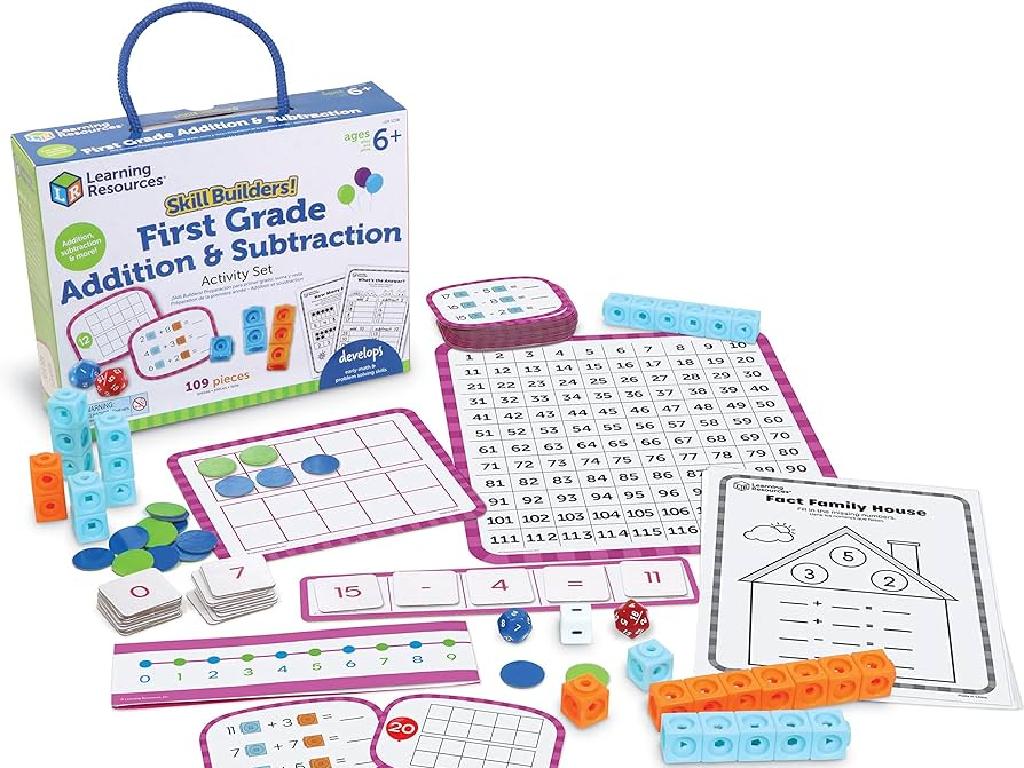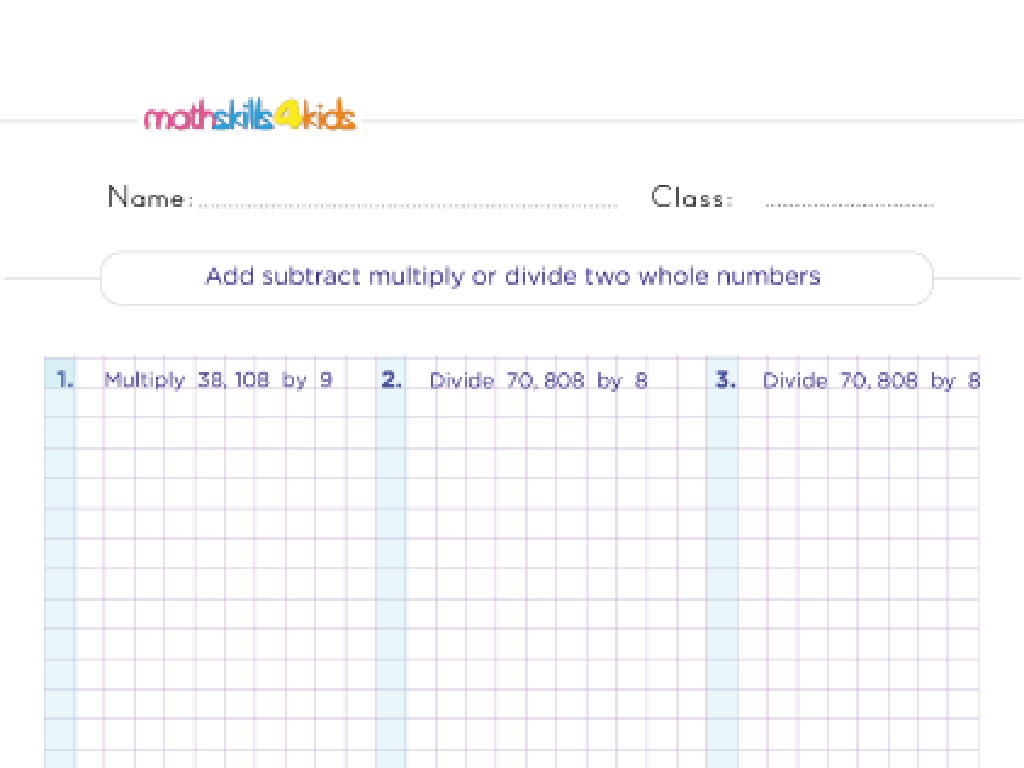Prime Or Composite
Subject: Math
Grade: Sixth grade
Topic: Number Theory
Please LOG IN to download the presentation. Access is available to registered users only.
View More Content
Prime and Composite Numbers
– What are Prime Numbers?
– A prime number has only two distinct divisors: 1 and itself.
– What are Composite Numbers?
– Composite numbers have more than two divisors.
– The role in number system
– They are the basic building blocks of all numbers.
– Importance of differentiation
– Knowing the difference helps in simplifying fractions and finding divisors.
|
This slide introduces the concept of prime and composite numbers, which are fundamental to the study of number theory. Prime numbers are those that are divisible only by 1 and themselves, with no other divisors. In contrast, composite numbers have additional divisors. Understanding these concepts is crucial as they form the basis of our number system. Differentiating between prime and composite numbers is important for various mathematical operations, such as simplifying fractions and finding the greatest common divisor. Encourage students to think of numbers as building blocks that can be constructed from primes, much like molecules made from atoms.
Exploring Prime Numbers
– Definition of prime numbers
– A prime number is only divisible by 1 and itself, like 2, 3, 5…
– Examples of prime numbers
– Prime examples include 2 (the only even prime), 3, 5, 7, 11…
– Characteristics of primes
– Primes have exactly two distinct divisors and are the building blocks of numbers.
– Significance in mathematics
– Primes are crucial for number theory and cryptography.
|
This slide introduces the concept of prime numbers, which are fundamental in mathematics, especially in number theory. Start by defining prime numbers and ensure students understand the concept of divisors. Provide clear examples of prime numbers, starting with the smallest prime, 2, and explain that it is the only even prime number. Discuss the unique characteristics of prime numbers, such as having exactly two distinct divisors: 1 and the number itself. Emphasize the importance of prime numbers in various fields of mathematics and real-world applications like cryptography. Encourage students to identify prime numbers and consider their role as the ‘building blocks’ of the number system.
Identifying Prime Numbers
– What is a Prime Number?
– A prime number has only two distinct divisors: 1 and itself.
– Divisibility Rules for Primeness
– Use rules like checking divisibility by 2, 3, 5, etc., to test if a number is prime.
– Activity: Find Primes in a Range
– Use the rules to find all prime numbers between 1 and 50.
|
This slide introduces the concept of prime numbers, which are numbers greater than 1 that have no divisors other than 1 and themselves. Explain the divisibility rules that can help determine if a number is prime, such as a number being even (divisible by 2) means it’s not prime unless it is 2. For the activity, students will apply these rules to identify all the prime numbers within a specified range, such as 1 to 50. This exercise will help reinforce their understanding of prime numbers and divisibility. Provide guidance on how to systematically check each number and encourage students to work in pairs or groups to foster collaboration.
Exploring Composite Numbers
– Define composite numbers
– A number with more than two factors, e.g., 4, 6, 8, 9, 10
– Examples of composite numbers
– 4 (2×2), 6 (2×3), 8 (2x2x2), 9 (3×3), 10 (2×5)
– Factoring composite numbers
– Break down into smaller factors
– Composite numbers in math
|
This slide introduces the concept of composite numbers, which are positive integers that have more than two factors. The definition should be clear and understandable for sixth graders. Provide examples of composite numbers and show how they can be factored into smaller numbers, which is a key property of composite numbers. Emphasize that understanding the factorization of composite numbers is fundamental in number theory and has practical applications in various areas of mathematics. Encourage students to practice by finding factors of different composite numbers and recognizing patterns in factorization.
Factoring Composite Numbers
– Breaking down composite numbers
– Decompose a number into prime factors
– Example: Factoring 12
– 12 can be factored into 2 x 2 x 3
– Activity: Factoring practice
– Factor a given list of composite numbers
|
This slide introduces the concept of factoring composite numbers into their prime factors. Start by explaining that composite numbers are made up of prime numbers multiplied together. Use the number 12 as an example to show how it can be broken down into 2 x 2 x 3. For the activity, provide students with a list of composite numbers and have them practice factoring each one into its prime components. This exercise will help solidify their understanding of prime and composite numbers and how they relate to each other in number theory. Encourage students to work in pairs or groups to foster collaborative learning and discussion.
Prime vs Composite Numbers
– Recap: Prime vs Composite
– Prime numbers have only two factors: 1 and themselves. Composite numbers have more than two factors.
– Number 1: Neither Prime nor Composite
– 1 is unique; it’s not prime because it has only one factor, not two.
– Quick Quiz: Prime or Composite?
– We’ll test your knowledge with a few numbers to classify.
|
Begin with a brief review of the definitions of prime and composite numbers, emphasizing the number of factors each type has. Clarify the special status of the number 1, which is neither prime nor composite, to ensure students don’t get confused by this exception. Follow up with a quick quiz to engage the students and assess their understanding. Provide a list of numbers and ask the students to identify them as prime or composite. This activity will reinforce their learning and provide an opportunity for immediate feedback. Encourage students to explain their reasoning for each answer to foster a deeper understanding.
Real-World Applications of Prime and Composite Numbers
– Prime numbers in cryptography
– Used to encrypt data, making it secure
– Composite numbers in daily life
– Found in calendar cycles, product barcodes
– Discuss other applications
– Where else might these numbers be important?
|
This slide aims to connect the abstract concepts of prime and composite numbers with practical applications that impact students’ lives. Prime numbers play a crucial role in computer security, particularly in cryptography, where they are used to encrypt information, making it difficult for unauthorized parties to access. Composite numbers are also part of our everyday life, seen in things like calendar cycles or the barcodes on products we buy. Encourage students to think critically about other areas where prime and composite numbers might be used, such as in architecture, music, or even gaming algorithms. This discussion can help them appreciate the relevance of number theory in various fields.
Prime and Composite Number Hunt
– Explore the classroom on a number hunt
– Count objects and categorize numbers
– Is the total count Prime (only divisible by 1 and itself) or Composite (has more than two factors)?
– Share findings with the class
– Explain why numbers are Prime or Composite
– Use examples to justify if a number is Prime (e.g., 7) or Composite (e.g., 8)
|
This interactive activity encourages students to apply their knowledge of prime and composite numbers in a fun and engaging way. Have students walk around the classroom to count items such as desks, books, or tiles and then determine if the total number is prime or composite. After the hunt, each student will share their findings with the class and explain the reasoning behind their categorization. For the teacher: Prepare a list of objects in the classroom that can be counted, ensure there’s a mix of prime and composite numbers, and be ready to guide students who may struggle with the concept. Have additional examples ready for clarification and encourage students to think critically about the factors of the numbers they find.
Conclusion: Prime and Composite Numbers
– Recap: What are prime numbers?
– Primes have only two factors: 1 and themselves
– Recap: What are composite numbers?
– Composites have more than two factors
– Homework: Categorize 10 numbers
– Next Class: Greatest Common Divisors
– We’ll learn how to find the GCD of numbers
|
As we wrap up today’s lesson, remind students that prime numbers are those that have exactly two distinct positive divisors: 1 and the number itself. Composite numbers, on the other hand, have more than two factors. For homework, students should find 10 numbers around their home or in their daily life and determine whether each is prime or composite. This exercise will help reinforce their understanding of the concepts. In preparation for the next class, give a brief introduction to the concept of Greatest Common Divisors (GCD) and how it relates to prime and composite numbers, setting the stage for the upcoming lesson.






